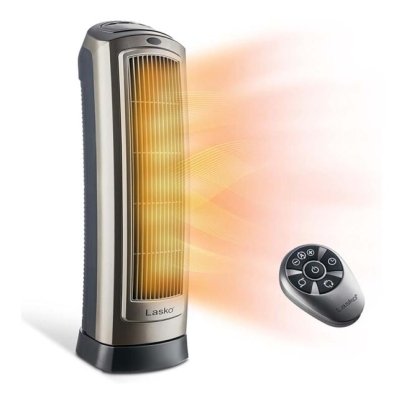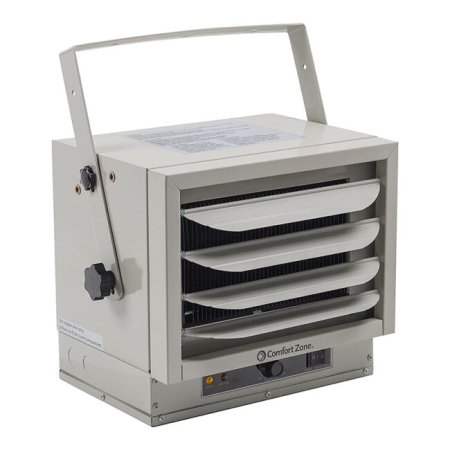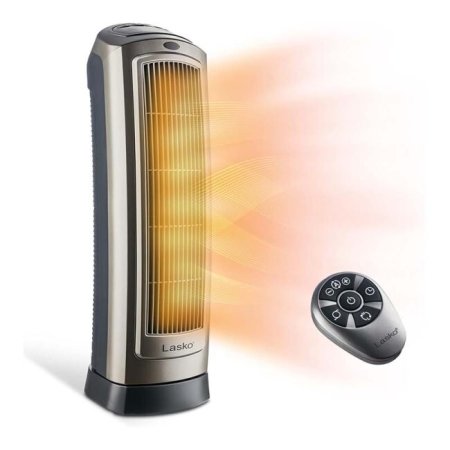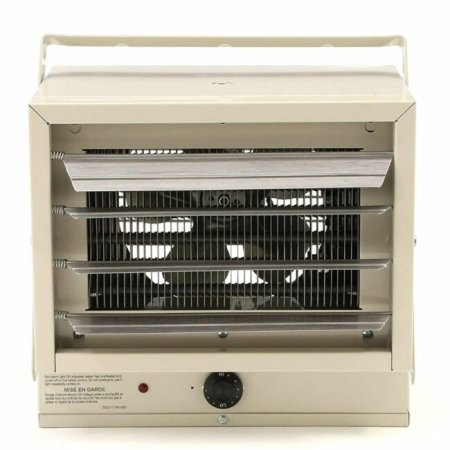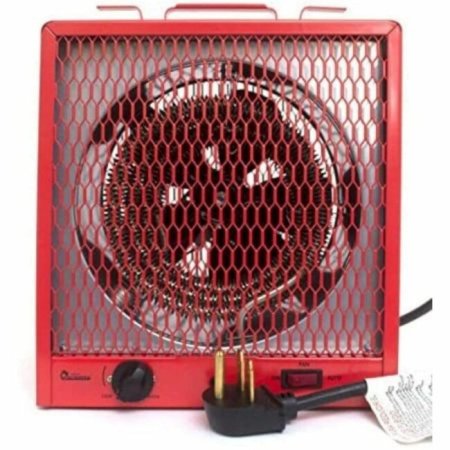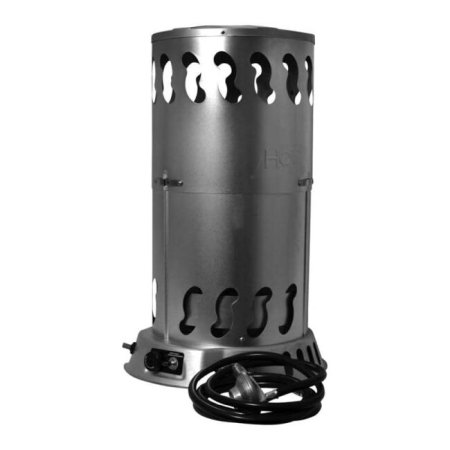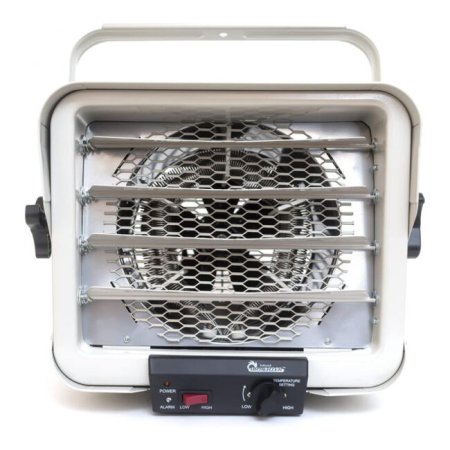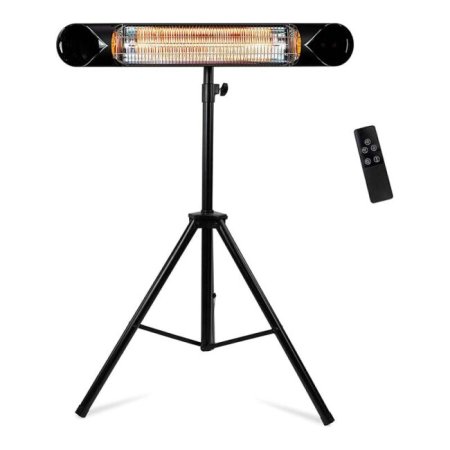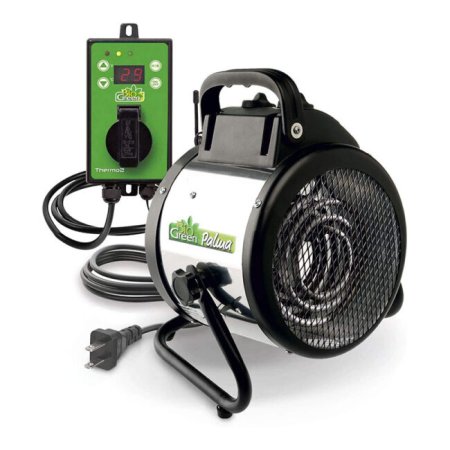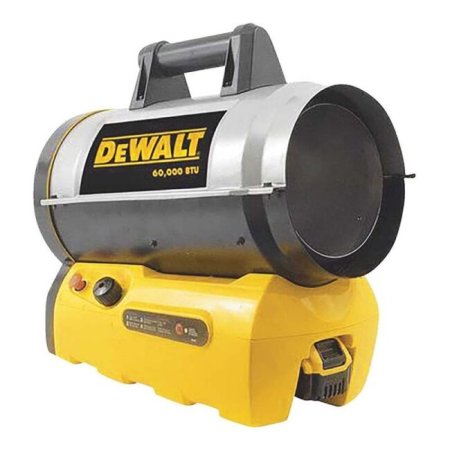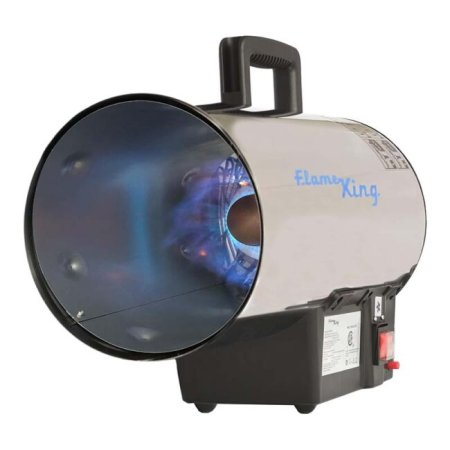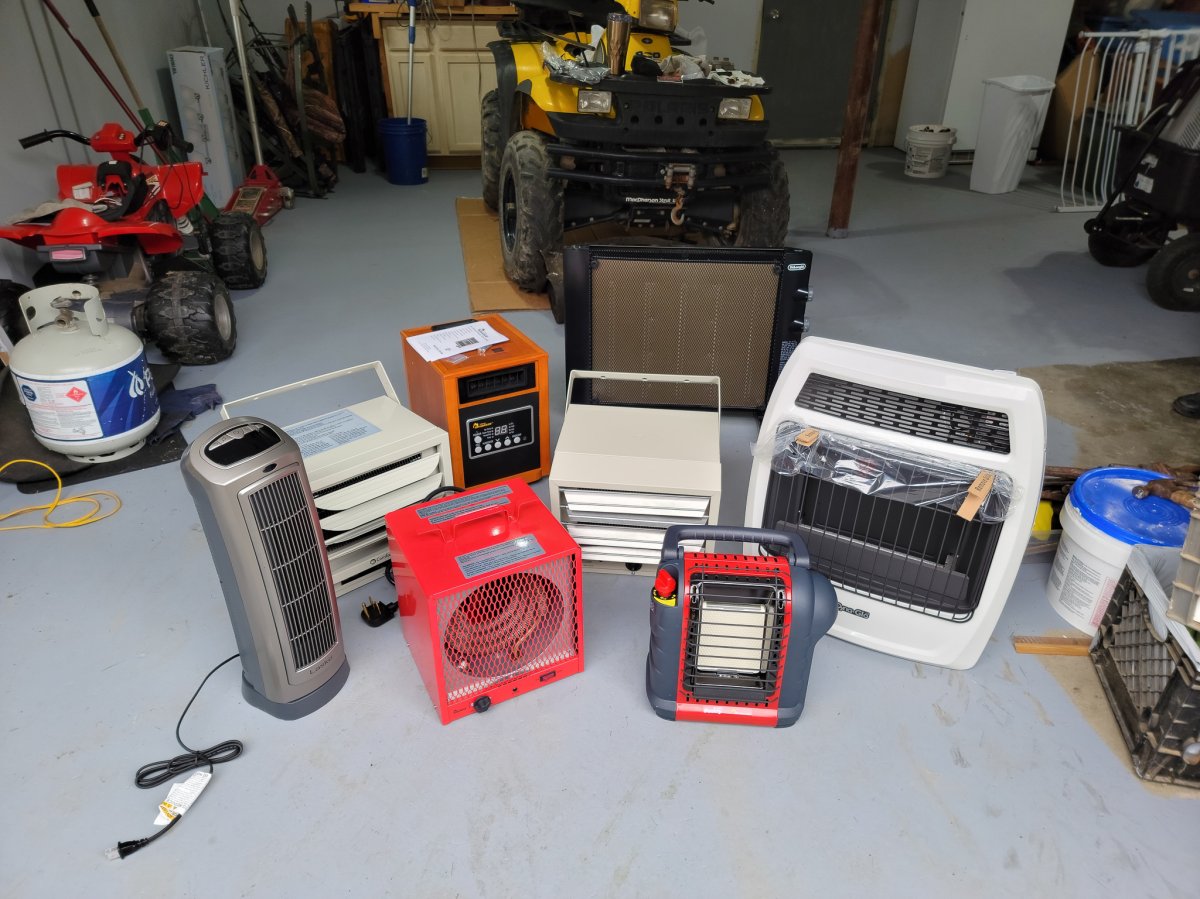
We may earn revenue from the products available on this page and participate in affiliate programs. Learn More ›
For DIYers and hobbyists, a garage can often be project central. It can be the place to store tools and to work on a variety of projects—even when temperatures are low.
Fortunately, a garage heater can banish the shivers when it’s cold out. Selecting the best heater for a garage depends on several factors, including the size of the garage, the preferred type of fuel, the importance of portability, and essential safety features.
Keep reading to learn more about some of the best garage heaters, as well as what we experienced during hands-on testing with our favorite products.
- BEST OVERALL: Comfort Zone Ceiling-Mounted Industrial Heater
- BEST BANG FOR THE BUCK: Lasko Digital Ceramic Space Heater With Remote
- BEST FOR CEILINGS: Fahrenheat FUH Electric Garage Heater
- BEST INFRARED: Dr. Infrared Heater DR-988 Portable Industrial Heater
- BEST FOR BARNS: Mr. Heater MH200CVX Propane Convection Heater
- BEST COMMERCIAL-GRADE: Dr. Infrared Heater DR-966 240-Volt Commercial Heater
- BEST INDOOR/OUTDOOR: Briza Infrared Carbon Indoor/Outdoor Heater
- BEST FOR PLUMBED GARAGES: Bio Green 110-Volt Palma Greenhouse Fan Heater
- BEST CORDLESS IGNITION: DeWalt 20V MAX Cordless Forced-Air Propane Heater
- ALSO CONSIDER: Flame King Portable Propane Forced-Air Heater

How We Tested the Best Garage Heaters
We put these garage heaters through their paces, considering installation, output, and (to a degree) safety features. First, we removed each unit from the box and set it up according to the manufacturer’s instructions. Many didn’t need any setup, while others required attaching legs, hanging brackets, and installing wiring. We took note of each, relative to the type of heater, as we expected gas and 220-volt heaters to be a little more involved.
Then, the heaters were tested for output. We turned each heater on inside the garage, taking note of how long it took to reach the desired temperature. At this point, we evaluated the additional features, such as humidifiers, thermostats, and timers.
Finally, we checked each heater’s safety features, such as cool-touch surfaces and tip-over shutoffs. Replicating the low-oxygen cutoff would’ve been dangerous, so we took the manufacturer’s word for it.
Our Top Picks
The lineup below includes some excellent heaters that we hand tested in real-life situations. They proved to be top-notch in their heating method for heat output, safety, and overall quality. Organized by category, this list can help folks find the best garage heater to stay warm while working.
Best Overall
Comfort Zone Ceiling-Mounted Industrial Heater
Product Specs
- Power source: Electric, 240 volts
- Installation style: Mounted
- Heating method: Forced air
This Bob Vila Approved product carries our brand’s highest level of recommendation.

Bob Vila Approved recognizes the household and DIY products that impressed us most in our real-world testing and that exemplify core values of the Bob Vila brand, including craftsmanship, innovation, and value for the dollar. Winners of this designation come recommended by our professional review team and are personally approved by Bob Vila.
What We Like
- Simple to install; can be hardwired or fit with a cord for a 30-amp outlet
- Grill is very easy to remove and take apart for cleaning when necessary
- This model pumps out plenty of heat, and it’s easy to control temperature
What We Don’t Like
- Does not come with the needed wire or cable clamp; separate purchases required
The Comfort Zone electric garage heater is a semipermanent option that mounts on a ceiling or a wall. It can be hardwired into the home electrical system, or fit it with a plug-in cord for a 30-amp outlet. The heater’s durable steel body is resistant to impact damage, and a dual-knob thermostat at the base makes it easy to control the temperature in the garage.
This 5,000-watt forced-air electric heater has adjustable louvers and a variable-angle mounting bracket to direct airflow wherever necessary. A built-in sensor in this garage heater ensures that the unit won’t overheat. If the temperature gets too high, the device switches off immediately to prevent internal or external damage. It proved to put out plenty of heat.
While the Comfort Zone is a quality garage heater, setting it up was a bit of a mixed bag. It didn’t come with the 240-volt pigtail or box entry (the cable clamp that secures the wire to the box), so these must be separate purchases. Otherwise, it was very easy to set up. Another plus: Removing the grill is simple, making future cleanings a breeze.
Get the Comfort Zone garage heater at Amazon.
Best Bang for the Buck
Lasko Digital Ceramic Space Heater With Remote
Product Specs
- Power source: Electric, 120 volts
- Installation style: Portable
- Heating method: Forced air
What We Like
- Remote control for adjusting temperature and modes
- Very powerful heat output yet super-quiet operation; won’t distract users with noise
- Has an oscillation mode, overheating protection, and cool-touch exterior
What We Don’t Like
- No tip-over protection; continues to heat when knocked down
The Lasko ceramic space heater is well suited for the garage—or any indoor location where a bit of extra warmth would be welcome. Just pick it up by the built-in handle and find a suitable location with an accessible power outlet. The heater can be adjusted via the control panel on the top of the unit or with the included remote.
Once the heater is turned on, users can opt to set an automatic timer that will turn it off when it reaches the scheduled time, or let it run nonstop until it is switched off manually. The 1,500-watt heater boasts several additional features, including oscillation, overheating protection, and a cool-touch exterior so that users can maneuver the unit while it is in use without getting burned.
During testing, the Lasko proved to be a surprisingly powerful (and very quiet) heater. While it wasn’t able to heat the whole garage, it did make a significant difference in the immediate area. We also liked that it has a remote control for adjusting the temperature and swapping through modes. The oscillation mode is particularly nice for spreading a bit of heat over a larger area, like a workbench or a shop floor. The only complaint is that this fairly tall heater doesn’t have any tip-over protection. We left it face down on the garage floor for over a minute, and it just continued to heat.
Get the Lasko garage heater at Amazon.
Best for Ceilings
Fahrenheat FUH Electric Garage Heater
Product Specs
- Power source: Electric, 240 volts
- Installation style: Portable
- Heating method: Forced air
What We Like
- Simple bracket style makes installing this model on the ceiling easy and straightforward
- Compact yet durable design ensures that it will last for years in most workshops
- The shroud has positionable louvers that aim heat downward, effectively warming the area below
What We Don’t Like
- Necessary wire or knockout cable clamp are not included; separate purchases required
- Does not include a power cord; must be direct wired
Midrange electric garage heaters like this are a good choice for those who prefer a ceiling-mounted heater. This powerhouse has a built-in overheating detection system that will shut down if the temperature gets dangerously high.
Control the heat output with the simple analog dial at the base of the unit and redirect the flow of warmth with the adjustable mounting bracket and louvers. This 5,000-watt heater comes with a built-in thermostat and a thermal safety shutoff. However, the unit does not include a power cord, so it must be direct wired to a dedicated 240-volt outlet with a 30-amp breaker.
During testing, the Fahrenheat FUH electric heater proved to be a solid choice in a compact design. The hanging bracket was easy to install, and adjusting the angle of the heater was as simple as loosening the two mounting nuts and positioning the unit. Also, this model’s shroud aims the heat downward, warming the space below it. But its lack of a 240-volt wire or cable clamp means shoppers will have to make separate purchases
Get the Fahrenheat garage heater at Amazon, Northern Tool + Equipment, or Blain’s Farm & Fleet.
Best Infrared
Dr. Infrared Heater DR-988 Portable Industrial Heater
Product Specs
- Power source: Electric, 240 volts
- Installation style: Portable
- Heating method: Infrared and forced air
What We Like
- Solid, heavy-duty construction feels like it will last in even the busiest workshops
- Simple setup and controls; includes auto function to maintain constant temperature
- Compact design produces a lot of heat; uses both infrared and forced air
What We Don’t Like
- Does not come with needed plug adapter
If infrared or fan-forced heating is more appealing than convection heat, then this Dr. Infrared garage heater is a great choice. It has a dual heating system that incorporates a radiant infrared heating element, which can quickly warm up physical objects, like people and tools, and it has a fan-forced heating system to warm up the air in the garage.
The heater needs a 208-volt or 240-volt connection to function properly, allowing it to run at up to 5,600 watts. Once the garage heater is set up in a safe location away from flammable material, the temperature dial can be set between 37 and 113 degrees Fahrenheit, and it will automatically maintain this temperature as long as the heater switch is on “auto.” The heater will run continuously with the switch set to “on.”
If ample heat is the primary goal from a compact heater, the Dr. Infrared Heater can deliver. Although this is an industrial-grade heater, there isn’t much setup or installation to do: Just remove it from the box. However, this unit does run on 240-volt electricity and uses a NEMA #6-30P plug, which many users may not have on hand (we didn’t); budget some extra cash for the outlet and an electrician, if needed.
Get the Dr. Infrared Heater DR-988 garage heater at Amazon or Target.
Best for Barns
Mr. Heater MH200CVX Propane Convection Heater
Product Specs
- Power source: None, piezo heater
- Installation style: Portable
- Heating method: Convection
What We Like
- Tons of heat output at its maximum setting makes it suitable for large garages
- Top section collapses and slides down over the lower section for easier storage
- It doesn’t need electricity thanks to the piezo ignitor, making it great for barns without power
What We Don’t Like
- It produces 75,000 British thermal units (BTUs) on low, which is too much for a small garage
When it comes to heating large barns and garages, Mr. Heater’s propane convection heater might be the top choice. This large, barrel-style heater produces between 75,000 and 200,000 BTUs, meaning it can heat up to 5,000 square feet of garage space. And since the heater works on convection, it will start a cycle that helps warm the space evenly.
This Mr. Heater model features a collapsible upper section that slides down over the lower section when not in use. This makes it easy to store. It also has a thermoelectric safety valve to shut the unit off if the flame goes out.
If there’s one thing our test revealed, it’s that this heater is built for wide open spaces (within a barn or garage, of course). Even at its lowest setting, it produces 75,000 BTUs, filling the space quickly with heat. We felt our small test garage heat up within a few minutes, and it raised the temperature 15 degrees Fahrenheit in 20 minutes. However, it’s likely too much heater for a small garage, but the fact that it doesn’t require electricity means it can be used to keep horse barns, construction sites, and other similar off-grid buildings warm.
Get the Mr. Heater garage heater at The Home Depot (2-pack).
Best Commercial-Grade
Dr. Infrared Heater DR-966 240-Volt Commercial Heater
Product Specs
- Power source: Electric, 240 volts
- Installation style: Wall or ceiling mount
- Heating method: Forced air
What We Like
- Design is smoother and more attractive than most similar commercial heaters, which are typically very boxy
- Hardware in this kit is of higher quality than most other garage heaters
- Tilting louvers allow users to direct airflow exactly where it’s wanted
What We Don’t Like
- Will most likely require an electrician to run the 240-volt circuit
- Product description infers that a wall-mounted thermostat is included, but our test unit didn’t have one
The Dr. Infrared 240-volt commercial heater might be a great option for those in the market for a high-quality heater with ample output. This model features two modes: 3,000 watts and 6,000 watts. It has an adjustable thermostat built into the heater, but it also comes with an additional thermostat to install on the wall for better control of the temperature. It is a direct-wire application, meaning that instead of a cord to plug in, the installer hardwires it into a 240-volt circuit.
We’ve tested a few of these wall- and ceiling-mount heaters, and this Dr. Infrared hardwired shop heater is one of the nicest. The design is smooth and appealing, rather than overly boxy like most other models. The oversize plastic knobs make it easy to lock the heater in place once users find the ideal angle. This makes a big difference, as these knobs were easier to use than smaller hardware typically found on other similar heaters. If the unit is to be ceiling mounted, its louvers are adjustable to direct airflow down or away from the work area.
Although the built-in thermostat doesn’t indicate temperature values that users can set precisely, once they get an idea of how much warmth they need in their garage, they’ll know where to set it. The biggest concern with this model is that most folks will have to hire an electrician to run 240-volt service to the heater so it can function in the majority of garages. Also, the product description makes it sound like it comes with a separate wall thermostat, but our test model did not.
Get the Dr. Infrared Heater DR-966 garage heater at Amazon, The Home Depot, or Dr. Heater.
Best Indoor/Outdoor
Briza Infrared Carbon Indoor/Outdoor Heater
Product Specs
- Power source: Electric, 120 volts
- Installation style: Portable or wall-mounted
- Heating method: Infrared
What We Like
- Produces plenty of heat with 3 settings; 750 watts (on low) and 1,500 watts (on high)
- Features flexible mounting options between wall and ceiling as well as sturdy, portable tripod
- Weatherproof indoor-outdoor design resists rain, snow, dust, and sand; ideal for garage, deck, or patio
What We Don’t Like
- No thermostat function to turn it on and off when desired temperature is reached
Anyone looking for a flexible garage heater that they can also use outside to keep the chill at bay will want to consider the Briza infrared electric indoor/outdoor heater. This infrared heater is weatherproof, allowing it to withstand rain, snow, sand, and dust. It also has three output settings.
The Briza boasts flexible mounting options. It comes with hardware to attach it to a wall or ceiling and also includes a portable telescoping tripod so that it can stand alone and be adjusted for height wherever it is placed. It has a remote control so users can adjust the temperature or set a timer without having to reach up to the unit (the timer is only available through the remote, in fact).
In testing, we were impressed by the amount of heat the Briza produced while also being incredibly quiet. It got so warm on the highest setting that we could barely stand in front of it, yet it emitted a barely audible hum. We also found infrared heat more comfortable than having a fan blowing hot air at us. Though at first we were a little skeptical of the tripod, it proved to be very sturdy and telescoped to the perfect height. Our only complaint is that while there are three settings, this heater doesn’t have a thermostat to turn it on and off when the room meets the desired temperature.
Get the Briza garage heater at Amazon, Walmart, or Briza Comfort.
Best for Plumbed Garages
Bio Green 110-Volt Palma Greenhouse Fan Heater
Product Specs
- Power source: Electric, 110 volts
- Installation style: Portable
- Heating method: Forced air
What We Like
- Runs very quietly to create a relaxed, distraction-free garage environment
- Splash-proof and constructed of stainless steel, it’s a rugged, durable option well suited to a garage
- Digital thermostat allows users to maintain the desired temperature in the space
- Can monitor and maintain lower temperatures than most space heaters, making it ideal for keeping garage plumbing from freezing
What We Don’t Like
- It produced an awful off-gassing odor when it was first fired up
Cold snaps can spell disaster for garages with water or sewer lines, but the Bio Green Palma fan heater lets folks avoid this problem. This heater can maintain temperatures around 48 degrees Fahrenheit—considerably lower than most space heaters. This allows the forced-air unit to run less often while still preventing frozen pipes. It features a 5,118 BTU 1,500-watt output and a digital thermostat for easy temperature setting.
During our test, we realized that the Palma heater’s value lies in its ability to maintain very low temperatures without allowing freezing—it’s not intended to give a garage Florida Keys-level warmth. And we found that it does this job quietly and very well. It’s well built, with a tough stainless housing, and it’s splash-proof to prevent damage from a bit of water. It doesn’t have a tip-over safety switch, but given its compact, stout size, it would be tough to knock it over by accident. Our only complaint about the Bio Green was the off-gassing smell it produced when it was first turned on.
Get the Bio Green garage heater at Amazon or Gardener’s Supply.
Best Cordless Ignition
DeWalt 20V MAX Cordless Forced-Air Propane Heater
Product Specs
- Power source: Battery, 20 volts
- Installation style: Portable
- Heating method: Forced air
What We Like
- Can be started with 20-volt MAX batteries or a plug-in cord
- Provides plenty of heat to keep medium-size garages warm
- Extremely lightweight design makes it easy to take where it’s needed
- It’s very stable and balanced on its large plastic base
What We Don’t Like
- No manual piezo lighter available, so if it the battery dies off-grid, it won’t start
Dewalt’s 20V MAX cordless forced-air propane heater allows users to take electric-start convenience on the road. This model uses any of the brand’s 20-volt MAX batteries to start the ignition process in the heater, automatically firing up while the user holds down the fuel valve button. Once lit, simply hold down the button for another 10 seconds (the directions say 30, but that wasn’t necessary), and the unit is ready to go.
This heater can start on corded power or cordless for added convenience. It has a maximum output of 68,000 BTUs and a minimum output of 27,000 BTUs. It also has a large plastic base for balance and stability without added weight. There is a high-temp limit switch that shuts off the unit for safety.
We really enjoyed this heater from DeWalt. First, it provides a lot of heat output for a smaller forced-air heater. It was able to make our small garage more comfortable within 20 minutes, though we still had to deal with some cold spots. We also liked that the base was very stable despite being made from plastic. It is quite loud, as most forced-air garage heaters are, and it doesn’t come with a manual ignitor, so users are out of luck if the battery dies off the grid.
Get the DeWalt garage heater at Amazon.
Also Consider
Flame King Portable Propane Forced-Air Heater
Product Specs
- Power source: Electric, 120 volts
- Installation style: Portable
- Heating method: Forced air
What We Like
- Offers plenty of safety features including a fuel shutoff, fire detection, and tip-over switch
- Reasonably good on fuel (8 hours on a 20-pound tank compared to 7 hours for most others)
- It’s very lightweight and easy to move around a garage
What We Don’t Like
- Comes with a stiff hose that can make positioning the the heater a bit tricky
Flame King’s portable propane forced-air heater is another small garage heater that’s worth considering. This smaller model features an output range between 30,000 and 60,000 BTUs, allowing it to heat medium-size garages. It features a plug-in electronic ignition and an adjustable output dial to help users achieve the perfect temperature in their garages.
This model from Flame King has tons of safety features. It has a low-oxygen fuel shutoff that activates when there isn’t any flame as well as a fire detections system and a tip-over switch.
The Flame King portable propane forced-air heater did quite well during our tests. It was easy to set up and use and produced plenty of heat for our small test garage. Temperatures started to feel comfortable after around 25 minutes of runtime. We also liked that this model is lightweight and extremely portable, though it is loud just like the other forced-air propane heaters in the test. Another point to consider is that the Flame King is relatively good on fuel, stretching a 20-pound tank to 8 hours while most heaters in the range take just 7 hours to empty a bottle.
Get the Flame King garage heater at Amazon or The Home Depot.
Jump to Our Top Picks
What to Consider When Choosing a Garage Heater
Before choosing the best heater for the garage, take a few minutes to learn about some of the most important shopping considerations, including heating method, fuel source, and heat output. There are also critical safety features that can help keep users safe while enjoying a garage heater.
Stationary vs. Portable Garage Heaters
DIYers will want to determine what’s most valuable in their garage: freed-up space on the counter or the floor, or the ability to work at a few different workstations. Knowing this should help when deciding whether to purchase a stationary or a portable garage heater.
Stationary
Busy DIYers may appreciate being free of the trip hazard that electric cords on the floor can create. Stationary garage heaters most often attach to the ceiling, but there also are options that mount to a wall.
There are a wide variety of energy options, sizes, and prices that range from a few hundred to a few thousand dollars. The downside to mounted heaters is that they typically cost more than their portable counterparts because they’re closer to commercial quality.
Portable
No matter the type of heating or fuel used, portable heaters focus warmth where it’s needed the most. Like space heaters on steroids, forced-air options feature large horizontal tubes that house the heating element and a powerful fan that delivers blasts of hot air.
While portable electric units often cost less, they can be less powerful than their multifuel counterparts. Alternatively, portable units can distribute warmth through radiant heat and convection.
Heating Method
Not all garage heaters control the temperature in the same way. There are three primary heating options: forced air, convection, and radiant.
- Forced-air garage heaters vary in size, fuel type, and price, but all operate by cycling blasts of hot air into the space.
- Gas-powered models tie into a home’s gas line. This tends to be cost-effective because natural gas and propane are often more affordable than the electricity required to produce the same heat. Gas-powered units, however, cost more up front than electric models, and local codes require installation by a licensed professional.
- Multifuel forced-air heaters work fast to produce heat, but their powerful fans can stir up debris and may feel uncomfortably warm if pointed directly at the user. Some models produce fumes and water vapor, making adequate ventilation necessary.
- Convection garage heaters include water- and oil-filled radiators. They rely on an enclosed flame or a heating element to warm the air within the unit, which then rises naturally without the help of a fan. Many are portable, but some—such as baseboard convection heaters—should be mounted.Convection heaters are better for heating entire rooms because they warm the air that circulates naturally, and they rate among the most affordable garage and shop heaters on the market. However, they can take a while to warm a garage to a tolerable temperature, and they won’t offer the intense heating effect of a forced-air or radiant heater.
- Radiant garage heaters feature highly polished reflectors that direct infrared heat outward for spot heating or—in the case of large overhead units—heating an entire garage. Radiant heaters warm objects directly in front of them (think of sitting near a campfire), so users can start feeling toasty fast if one is pointing in their direction. Because radiant heaters offer steady warmth without blowing air, they are well suited to DIYers who do woodwork since they won’t stir up dust particles. Powered by natural gas, propane, or electricity, these units are available either mounted or portable and in a range of sizes.
Fuel Source
Consumers have a wide range of energy options from which to choose when shopping for a garage heater. While heaters are most commonly fueled by electricity, propane, or natural gas, there are also those that run on diesel and kerosene.
Since electric garage heaters pull a lot of power, these usually require a designated electrical circuit on its own breaker. An electrician can tell if existing garage wiring is adequate to run an electric heater or if a new circuit should be installed.
If there is already natural gas service to a home, there is an option to install a natural gas heater. Propane-powered heaters can be installed on a home’s propane line, or individual tanks of propane to fuel smaller heaters can be purchased.
Heat Output
The best garage heater for a space can produce enough heat to be comfortable, without breaking the budget. Heat output for gas-powered heaters is measured in BTUs. Gas garage heaters typically range from 12,000 to 30,000 BTUs or more.
When trying to determine the heat output of an electric heater, a general guideline is to provide 10 watts of output for approximately every square foot of space. For example, a 100-square-foot room will require a heater with 1,000-watt output for adequate comfortable warmth.
Most heaters advertise the maximum square footage the unit can adequately heat with a standard 8-foot ceiling. If a garage has a higher ceiling, take that into consideration and pick a size up. Insulation will also affect the warmth factor in a garage. Even a high-capacity heater cannot prevent icy drafts from entering through poorly insulated doors and windows.
Safety
Safety must be a primary consideration when deciding on the best garage heater. To help keep the space safe and comfortable, manufacturers have added several features, including cool-touch exteriors, overheating protection, and automatic shut-off systems.
- Cool-touch exteriors are common with portable and wall-mounted garage heaters. The heater has a shell made of fiberglass or plastic, which are both poor conductors for heat. The exterior of the heater stays cool, despite the heat produced.
- Overheating protection ensures that the heater doesn’t burn out its own system. When the heater senses dangerous temperatures, it turns off to prevent internal damage to the unit and external damage to the room.
- Automatic shut-off systems are similar to overheating protection in that the response is to shut down the heater to prevent damage. This system is typically triggered if the heater is knocked over; however, some products also shut down if the heater senses a short in the wiring.
Additional Features
Various different features may add to the convenience and efficiency of a garage heater. These include programmable thermostats, oscillation, and remote controls.
- Programmable thermostats allow users to set a specific temperature using an electronic keypad or a remote, ensuring that the heater works to reach this temperature and then only activates to maintain the heat.
- Oscillation helps to properly distribute heated air via an almost 180-degree rotation. Though it is most common with portable garage heaters, some wall-mounted models can have oscillating louvers (vents) that can change the direction of the airflow.
- Remote controls offer the convenience of being able to operate the heater from anywhere in the room, so there’s no need to walk over to turn the heat off or to change the temperature setting.
Installation
Portable garage heaters only need to be positioned and provided with fuel or electricity to function. Wall- and ceiling-mounted garage heaters typically come with the hardware required to install the heater, but some products don’t have mounting brackets. Also, for hard-wired installations (these heaters don’t have plugs), it may be necessary to hire an electrician.
Mount a heater in the coldest corner of the garage, ensuring that ceiling-mounted models are at least 24 inches from the walls to reduce fire risk. Direct the heater toward the center of the garage and follow the manufacturer’s steps to make sure that the heater is installed according to its specifications.
FAQs
Even after becoming familiar with the best garage heaters, there may still be some lingering questions about the type, efficiency, and appropriate size. Below are answers to some of the most commonly asked questions about garage heaters to provide additional info.
The best type of heater for the garage depends on your needs. Large garages benefit from a natural gas or propane heater because of the high heating capacity, allowing the heater to adequately warm the space. However, an electric garage heater is a safer alternative and the heating capacity is suitable for smaller garages.
Depending on where you live, the answer to this question can vary. Areas with mild winters will naturally require less heat production to warm a space than locations with harsh, freezing winters.
However, an electric garage heater with 3,000 watts is usually needed to heat a 2-car garage. The best gas garage heater for a 2-car garage typically has a rating of about 18,000 BTUs to adequately heat the space.
Efficiency can be difficult to determine because an electric infrared heater technically has 100 percent efficiency, but it may actually cost more to operate than the best natural gas garage heater. This is due to the cost of electricity over natural gas or even propane. If you are looking for a heater that uses almost every watt of energy for heating, then an infrared heater can be the best option.
Yes, a garage heater can be too big. If it is too big, the excess heat produced quickly makes the garage feel uncomfortable, forcing you to open the door to release some heat. If you have a smaller garage, consider using a portable heater to keep the space warm.
It depends on the size of the garage. Typically, a good general guideline for electric heaters is that they provide 10 watts of output for every square foot of space. This means that as long as the garage is 150 square feet or smaller, a 1,500-watt heater is more than adequate.
Portable garage heaters can be placed anywhere. Fixed or mounted garage heaters should be installed in the coldest corner of the garage, directing the heat and airflow toward the center of the space. Make sure that heaters are installed at least 24 inches away from the walls, and always check the manufacturer’s directions so you install and use the unit properly.
Meet the Tester
Tom Scalisi is a full-time DIY and construction writer for many of the largest websites in the industry, including Bob Vila, This Old House, Family Handyman, and Forbes as well as his own pest control blog. His uninsulated garage makes winter projects tough in the Northeast, so he knows a thing or two about keeping warm out in the shop.

